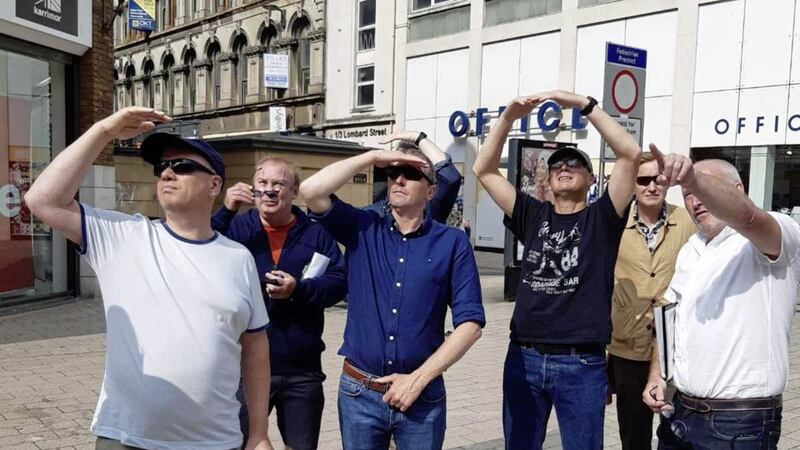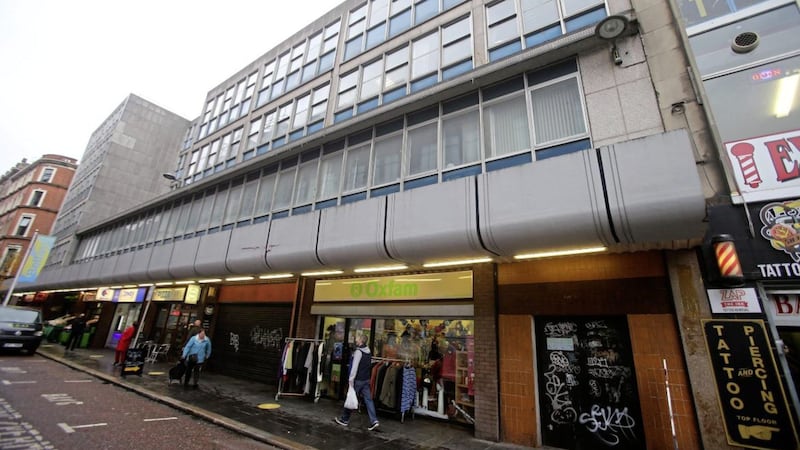WHENEVER I visit another city I will set about seeking out a local tour to show me around. It is surely the best way to learn the history and details of a place and when the guide has a bit of extra local knowledge then thats all the better. In this way I have gotten great insights into the stories of Rome, Berlin Luca in recent years.
After last weekend I can now add Belfast to that list. And in the process of taking that tour I learned that even when ploughing forward, its always good to look over your shoulder every now and then.
Together with a group of long time friends, who have kept one another’s spirits up during the lockdown, we marked the relaxation of some of the Covid restrictions by getting together and taking a two-hour walking tour under the guidance of Larry Murphy. We met at the outskirts of Cathedral Quarter, which of course was originally known as the Half Bap (that's the kind of detail you pick up from a good tour guide.)
Growing up in Belfast I have let the names of our streets pass me by over the years: Chichester Street, Donegall Square and Donegall Street, Arthur Street, Wellington Place…..each of them linked, like so many others, to the history of the city and those who formed what we now know as Belfast.
With the population explosion in the early 1800s, driven by industrialisation when Belfast was the linen capital of the world, when thousands came from all parts of Ireland to work in engineering, shipbuilding, joined by economic immigrants from Italy and elsewhere, Belfast was the dominant city in Ireland. In 1808, approximately 25,000 people lived in Belfast; by 1841, this number had almost tripled to 70,000; and by 1911, it had reached 385,000 and was far and away the largest city in Ireland.
At the heart of our tour was the story of the United Irishmen and in particular Henry Joy McCracken and his contemporaries. I did not know before last weekend that Henry Joy was born, lived out his activist days, was court-martialed and hanged all within a very small area that is now the commercial heart of Belfast.
Henry Joy McCracken was hanged above what is now Dunnes Stores. Progress eh? Even more impressive is the story of his sister, Mary Ann McCracken, whose progressive ideals lasted all her 96 years and saw her leading the campaign against the global slave trade until her final decades.
Our tour also covered the corporate rejection of a proposal that our city should join the global slave trade, with businessman and united Irishman Thomas McCabe famously pledging ‘May God eternally damn the soul of the man who subscribes the first guinea…’
I was most struck by the tale of William Drennan, who died two centuries ago this year. You may not have heard of Drennan or be fully aware of his life and the impact he had on Belfast which has echoed down the centuries since. Drennan was a political radical and one of the founders of the United Irishmen who sought political reform in Ireland in a way which would unite Protestant, Catholic and dissenter; he was also a physician and a poet who founded the Royal Belfast Academical Institution.
He moved to Dublin to work as a doctor and was a leader in the drive to promote inoculation against smallpox. In fac, from Dublin William Drennan sent messages to colleagues in Belfast urging people to wash their hands to protect against infection. Can you imagine that?
Over two hundred years ago signs were put up over the doors in public buildings urging the public to ‘wash hands to avoid infection’ at the behest of Dr William Drennan. I don’t want to make any readers feel inadequate, but in his spare time he christened the phrase ‘the Emerald Isle’ when writing a celebrated poem about his home country. I reckon he packed at a few lifetimes into this 66 years. It seems a shame, in fact, that the 200th anniversary of his death was hardly marked at all in his native city.
Every city is built on the actions of its leaders, be them in business, politics, religious or civic life, down through generations. The impact of those names from the past, some well known and some under appreciated to this day, formed the city of Belfast that we know today.
That goes for the civil servants and visionaries behind the Cathedral Quarter area and Terri Hooley and the punk movement of the 1970s and 1980s and the developers and planners who are today charged with shaping the future direction of Belfast and our other towns and cities.
So the next time you have a bite to eat in Hadskis, or the Muddlers Club, or a drink in Whites Tavern or Kelly's Cellars, or if you stroll down Hill Street past the site of the original Harp Bar, pause and reflect on how Belfast started, how far it has come and the men and women who forged our history.
And if you want any insights, give Larry a call.
Brendan Mulgrew is managing partner at MW Advocate (www.mwadvocate.com). Follow him on Twitter at @brendanbelfast








